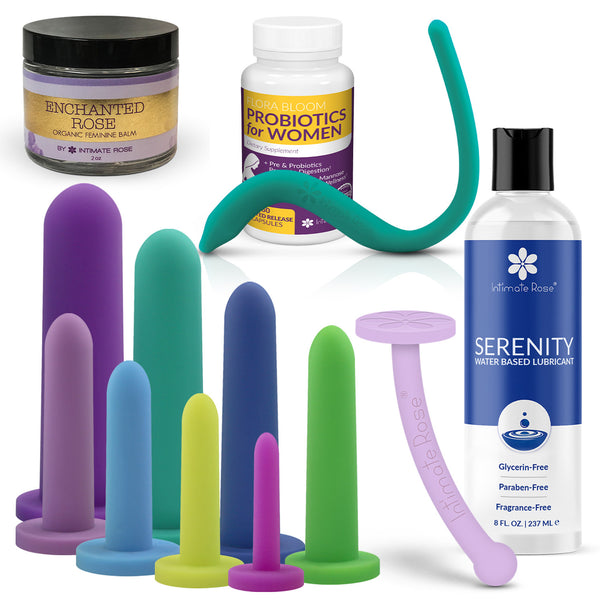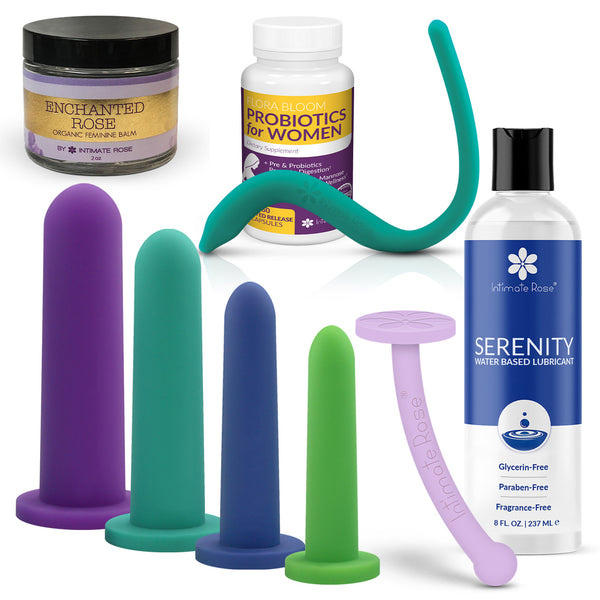Vaginismus is described as an unintentional and often painful tightening of the muscles around the vagina at the thought or initiation of penetration. It is uncomfortable, confusing, and involuntary, but it is also treatable.
Read on to understand vaginismus and treatment options, including therapy, exercises, and more.
What Is Vaginismus?
Vaginismus is referred to as an involuntary spasming of the pelvic floor muscles and vaginal tissues at the thought of something entering the vagina, like a penis, tampon, or gynecological instrument.
Due to the constriction of the vaginal entrance, vaginismus patients regularly describe a burning sensation or the feeling of the penis hitting a wall during penetrative sex.
What Causes Vaginismus?
Despite the exact cause of vaginismus not yet being determined, medical professionals believe it is triggered by an anxiety or fear of having intercourse, in that, the patient’s mind already expects penetration to be painful and so it tightens to protect itself.
For some women, the anxiety is linked to a physical condition such as a pelvic injury, vaginal dryness during menopause, discomfort from a yeast infection, vulvodynia, interstitial cystitis, or pelvic surgery.
For others, the anxiety might stem from a lack of sexual education, fear of becoming pregnant, being a victim or witness of sexual or domestic abuse, or painful sexual encounters in the past.
Vaginismus Types
Vaginismus is diagnosed as one of two types. Primary vaginismus is diagnosed when women have always experienced pain during vaginal penetration. The discomfort and anxiety of primary vaginismus can manifest as early as the teenage years when inserting the first tampon.
Secondary vaginismus, which is also referred to as acquired vaginismus, is diagnosed when women who have previously experienced pleasurable and pain-free sex, find that it has become painful later in life.
45-Min Online Pelvic Therapy Session, $99 
Vaginismus Symptoms
Ongoing dyspareunia, or painful sex, is typically the first sign of vaginismus. Most women report feeling pain during penetration, and no pain without penetration, while other women experience a constant feeling of tightness within the vagina.
This first symptom leads to the second symptom, which is an increase in anxiety and a compounding fear of sex, resulting in the third most common symptom, a lack of sexual desire. Ultimately, most women suffering from vaginismus abstain from sex completely due to the pain, embarrassment, or a combination of both.
Vaginismus Treatment Options
Unfortunately, many women suffering from vaginismus keep it a secret due to feelings of humiliation, however, vaginismus is a treatable condition, and up to 90% of women who undergo treatment enjoy a pleasurable sex life afterward.
The following are the top-rated vaginismus treatment options, including education, therapy, exercises, dilators, or vaginismus surgery.
Sex Therapy
If you or your healthcare provider feel that your vaginismus is triggered by a lack of sexual education, consider making an appointment with an experienced sex therapist. Your sessions can be a safe space just for you, or if you feel it could help them to understand your condition, your partner could join you.
Learning about the female and male anatomies, what happens during intercourse, and how vaginismus can affect your sex life can be extremely helpful.
Relaxation Therapy
If you can relax your mind, your body will follow, including your vaginal muscles. Admittedly, relaxing when you feel anxious is easier said than done but learning some relaxation techniques can make all the difference when managing vaginismus.
The type of relaxation therapy required will vary from woman to woman, depending on what may have triggered their fear of penetration in the first place. For example, those diagnosed with secondary vaginismus often benefit from learning how to relax with breathing exercises, meditation, and mind relaxation practices.
Whereas women diagnosed with primary or lifelong vaginismus may find more understanding about the source of their anxiety by speaking with a therapist who can teach applicable relaxation techniques for their particular circumstances.
It is important to note that relaxation therapy alone will not effectively treat vaginismus. Ideally, it is carried out in conjunction with physiotherapy, pelvic exercises, or dilation therapy.
Physical Therapy & Pelvic Exercises
Physical therapists specializing in pelvic floor treatment are skilled at treating vaginismus patients in their clinic as well as with pelvic floor exercises that can be practiced at home. This type of regular muscle memory training helps to relax and control the pelvic muscles to eliminate the involuntary spasming during penetration.
In conjunction with pelvic breathing, a pelvic floor physiotherapist will typically teach vaginismus patients the proper execution of pelvic training like, child’s pose, happy baby, deep squats, pelvic floor drops, and vaginal dilator therapy.
Vaginal Dilator Therapy
Vaginal dilator therapy is used to gently stretch tight vaginal muscles and minimize pain during intercourse. Vaginal Dilators usually come in sets of ascending sizes, allowing the user to get used to penetration with the smallest size before moving up to the next size.
This type of therapy increases blood flow to the vaginal tissues, slowly stretches and relaxes tight muscles, and elevates natural lubrication to make vaginal penetration easier and more pleasurable.
How does a vaginal dilator work?

Find training, videos, support and inspiration within our Dilator Hub
There are various brands and types of dilators available, all of which are made from either plastic or silicone. If your healthcare practitioner has recommended vaginal dilator therapy, it can help to seek out the help of a pelvic physiotherapist to learn how to insert and use vaginal dilators properly.
Intimate Rose Silicone Vaginal Dilators were designed by pelvic floor physical therapist, Amanda Olson, and are made from smooth, medical-grade silicone designed to glide into the vagina for more comfortable use during dilator therapy, and are cleread to treat symptoms related to vaginismus.
Vaginismus Surgery
Although it sounds ominous, vaginismus surgery is a short procedure where muscle-freezing botox injections are administered and massaged into the vaginal muscles. Just like botox prevents facial muscles from constricting by partially freezing them, it releases tightness in the vaginal muscles in the same way.
To eliminate a vaginismus patient’s fear of something entering the vagina, the procedure typically starts with sedation, and the botox injections are administered under anaesthetic. After surgery, a course of vaginal dilator therapy is usually recommended.
Relief generally lasts for 2-3 months post-surgery, allowing vaginismus patients the time to comfortably complete vaginal dilator therapy. After vaginismus surgery & the subsequent vaginal dilator training, the majority of patients report experiencing pain-free penetrable sex and require no further injections.
Conclusion
Vaginismus affects up to 7% of women worldwide, impacting not only their sex life, but mental health, physical health, and the quality of their relationships. What most patients don’t know is that vaginismus is nothing to be embarrassed about and it is treatable. In fact, up to 90% of women with vaginismus report enjoying a healthy sex life after treatment.
To determine which vaginismus treatment is best suited to you, read through the above options, ask your healthcare provider for recommendations on professionals in your area and schedule an appointment as soon as possible to find relief.
References
Cleveland Clinic - https://my.clevelandclinic.org/health/diseases/15723-vaginismus
Mayo Clinic – Painful Intercourse (Dyspareunia) - https://www.mayoclinic.org/diseases-conditions/painful-intercourse/symptoms-causes/syc-20375967
National Library of Medicine - Pelvic floor physical therapy in the treatment of pelvic floor dysfunction in women– Vaginismus https://pubmed.ncbi.nlm.nih.gov/31609735/
Very Well Health – Vaginal Dilators: What You Need to Know - https://www.verywellhealth.com/vaginal-dilators-5220401
Health System, University of Michigan - Vaginal Lubricants, Moisturizers,
Dilators & Counseling - https://www.med.umich.edu/1libr/PMR/SexualHealth/lubricants.pdf
Journal of the Society of American Plastic Surgeons – Botox Treatment for Vaginismus - https://journals.lww.com/plasreconsurg/fulltext/2009/12000/botox_treatment_for_vaginismus.86.aspx

45-Min Online Pelvic Therapy Session, $99











